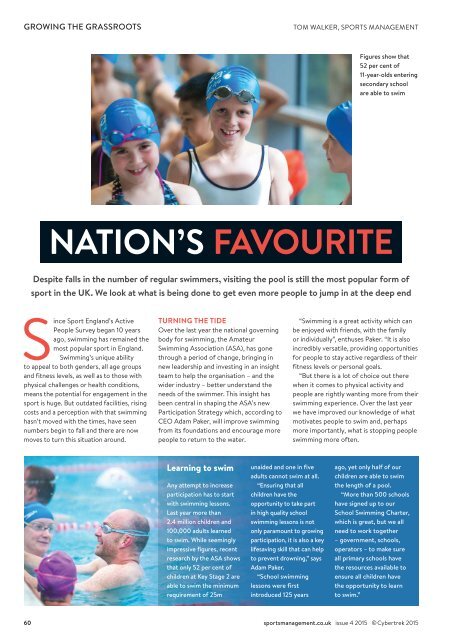EDDIE IZZARD
SM_issue4_2015
SM_issue4_2015
Create successful ePaper yourself
Turn your PDF publications into a flip-book with our unique Google optimized e-Paper software.
GROWING THE GRASSROOTS<br />
TOM WALKER, SPORTS MANAGEMENT<br />
Figures show that<br />
52 per cent of<br />
11-year-olds entering<br />
secondary school<br />
are able to swim<br />
NATION’S FAVOURITE<br />
Despite falls in the number of regular swimmers, visiting the pool is still the most popular form of<br />
sport in the UK. We look at what is being done to get even more people to jump in at the deep end<br />
Since Sport England’s Active<br />
People Survey began 10 years<br />
ago, swimming has remained the<br />
most popular sport in England.<br />
Swimming’s unique ability<br />
to appeal to both genders, all age groups<br />
and fitness levels, as well as to those with<br />
physical challenges or health conditions,<br />
means the potential for engagement in the<br />
sport is huge. But outdated facilities, rising<br />
costs and a perception with that swimming<br />
hasn’t moved with the times, have seen<br />
numbers begin to fall and there are now<br />
moves to turn this situation around.<br />
TURNING THE TIDE<br />
Over the last year the national governing<br />
body for swimming, the Amateur<br />
Swimming Association (ASA), has gone<br />
through a period of change, bringing in<br />
new leadership and investing in an insight<br />
team to help the organisation – and the<br />
wider industry – better understand the<br />
needs of the swimmer. This insight has<br />
been central in shaping the ASA’s new<br />
Participation Strategy which, according to<br />
CEO Adam Paker, will improve swimming<br />
from its foundations and encourage more<br />
people to return to the water.<br />
“Swimming is a great activity which can<br />
be enjoyed with friends, with the family<br />
or individually”, enthuses Paker. “It is also<br />
incredibly versatile, providing opportunities<br />
for people to stay active regardless of their<br />
fitness levels or personal goals.<br />
“But there is a lot of choice out there<br />
when it comes to physical activity and<br />
people are rightly wanting more from their<br />
swimming experience. Over the last year<br />
we have improved our knowledge of what<br />
motivates people to swim and, perhaps<br />
more importantly, what is stopping people<br />
swimming more often.<br />
Learning to swim<br />
Any attempt to increase<br />
participation has to start<br />
with swimming lessons.<br />
Last year more than<br />
2.4 million children and<br />
100,000 adults learned<br />
to swim. While seemingly<br />
impressive figures, recent<br />
research by the ASA shows<br />
that only 52 per cent of<br />
children at Key Stage 2 are<br />
able to swim the minimum<br />
requirement of 25m<br />
unaided and one in five<br />
adults cannot swim at all.<br />
“Ensuring that all<br />
children have the<br />
opportunity to take part<br />
in high quality school<br />
swimming lessons is not<br />
only paramount to growing<br />
participation, it is also a key<br />
lifesaving skill that can help<br />
to prevent drowning,” says<br />
Adam Paker.<br />
“School swimming<br />
lessons were first<br />
introduced 125 years<br />
ago, yet only half of our<br />
children are able to swim<br />
the length of a pool.<br />
“More than 500 schools<br />
have signed up to our<br />
School Swimming Charter,<br />
which is great, but we all<br />
need to work together<br />
– government, schools,<br />
operators – to make sure<br />
all primary schools have<br />
the resources available to<br />
ensure all children have<br />
the opportunity to learn<br />
to swim.”<br />
60<br />
sportsmanagement.co.uk issue 4 2015 © Cybertrek 2015


